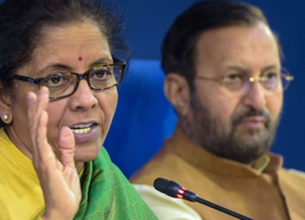WAYS AND MEANS ADVANCE SCHEME
02, Apr 2020

Prelims level : Schemes
Mains level : GS-II Welfare schemes for vulnerable sections of the population by the Centre and States and the performance of these schemes; mechanisms, laws, institutions and Bodies constituted for the protection and betterment of these Vulnerable Sections.
Why in News?
- The Government has recently hiked Ways and Means Advance (WMA) limit with the Reserve Bank of India (RBI) by 60%.
Highlights:
- The government has announced a Rs 1.7 lakh crore package (Pradhan Mantri Garib Kalyan Yojana) to provide income support, free food and other facilities to the poor to help them during the 21-day national lockdown.
- The fundraising resources are not only from the market, but also from institutions such as the RBI.
- The 2020-21 budget has pegged the Centre’s net market borrowing, including government securities, treasury bills and post office life insurance fund.
- In FY21, the Centre also plans to issue the Debt Exchange Traded Fund comprising government securities to widen the base of investors.
- This will enable retail investors, who otherwise find it difficult to buy government bonds directly, take an exposure in this risk free instrument.
About Ways and means Advance scheme:
- It was introduced in 1997 to meet mismatches in the receipts and payments of the government.
- The government can avail of immediate cash from the RBI, if required. But it has to return the amount within 90 days. Interest is charged at the existing repo rate.
- If exceeds 90 days, it would be treated as an overdraft (the interest rate on overdrafts is 2 percentage points more than the repo rate).
- Its limits are decided by the government and RBI mutually and revised periodically. A higher limit provides the government flexibility to raise funds from RBI without borrowing them from the market.
- There are two types of Ways and Means Advances, Special WMA and Normal WMA
- Special WMA or Special Drawing Facility is provided against the collateral of the government securities held by the state. After the state has exhausted the limit of SDF, it gets normal WMA. The interest rate for SDF is one percentage point less than the repo rate.
- The loans Normal WMA is based on a three-year average of actual revenue and capital expenditure of the state.
About Exchange Traded Fund:
- It is a basket of securities that trade on an exchange, just like a stock.
- It reflects the composition of an Index, like BSE Sensex. Its trading value is based on the Net Asset Value (NAV) of the underlying stocks (such as shares) that it represents.
- It shares prices fluctuate all day as it is bought and sold. This is different from mutual funds that only trade once a day after the market closes.
- It can own hundreds or thousands of stocks across various industries, or it could be isolated to one particular industry or sector.







